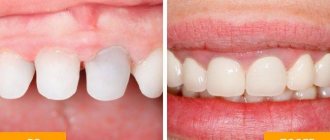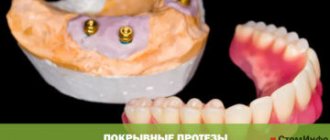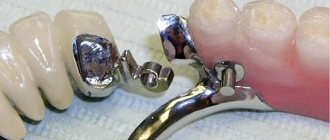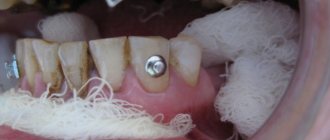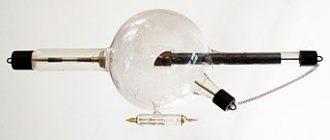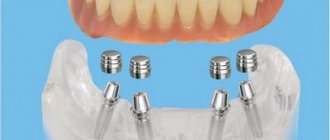Are you planning microimplant orthodontic treatment with the installation of braces? Perhaps you, as a potential patient, are considering microimplants as an alternative to traditional implants that are screwed into the bone? Everything you need to know about microimplants, indications for their use and possible contraindications is in our material. Experts share their independent opinions and reveal facts that are not always discussed in dentistry. Read the material to the end to be aware of all the important nuances.
Mini dental implants and mini implantation
Mini-implantation is one of the youngest trends in dentistry. Mini dental implants were developed in the USA in the early 2000s, and since about 2004, the technique has been actively used by specialists from Europe. In dentistry, mini dental implants are titanium pins with a diameter of about 2 millimeters: they are almost four times smaller than classic dental implants, so they can be used in very limited spaces. As a rule, mini-implants have a one-piece design that combines a titanium rod and an abutment on which an orthopedic structure is attached. Today, mini dental implants are produced by many top manufacturers, including companies such as Nobel Biocare, XiVE and Zimmer.
- Mini implants can be installed even in very limited spaces.
- Installation of mini-implants does not require bone grafting.
- Possibility of immediate prosthetics with a removable structure after the surgical stage.
- Fast healing time and non-traumatic installation of mini-implants.
- Removable dentures on mini-implants at a price significantly lower than designs using classic dental implants.
- Limited application possibilities. Impossibility of single crown prosthetics and installation of fixed structures.
- Complete osseointegration does not occur.
- More complex hygiene.
General information about microimplants
Microimplants are small (about one millimeter in diameter) titanium pins that are screwed into the patient’s bone and pass through the gums, thereby providing a reliable support for the orthodontic brace system. They perform a temporary function if they are placed during orthodontic treatment.
Visually, a microimplant is similar to a miniscrew, but has a specific head. The total length of the microimplant is from 0.6 to 1.2 cm. Unlike classical implants, the microimplant is screwed into the patient’s gums and, if necessary, can be removed without damaging living tissue.
Mini dental implants: indications for use
It is obvious that new treatment opportunities are opening up largely due to the miniature size of such implants. They can be used in patients with a very narrow alveolar ridge (the area that forms after a natural tooth is removed). But the main advantage, due to which mini-implantation has become very widely used, is that the height and density of bone tissue practically does not matter. The MDI implant is implanted into soft tissue with minimal impact on the bone.
The classic implantation procedure usually involves an incision in the gum. Installation of mini-implants is carried out using the transgingival method - using a small incision. The entire procedure becomes less invasive (traumatic), which minimizes the risk of inflammation and shortens the healing time.
Scope of application of microscrews
Microimplants are successfully used for orthodontic and orthopedic manipulations. In prosthetics, they help stabilize removable fastenings where teeth are completely absent and the patient’s bone tissue has atrophied. Using miniscrews you can achieve:
- ensuring strong fixation of the entire fastening;
- maximum density due to the implantation of four microimplants into the lower part of the jaw;
- fixation of up to 6 elements in the upper jaw to reduce the looseness of the bone contents.
Two mini-implants for installing a prosthesis.
After installing the implants, special fasteners are built into the removable installation for stable stability. This approach ensures that the dentures are worn securely.
The use of microimplants is indispensable in order to correct the bite and straighten the teeth. They are combined with braces to speed up the effectiveness of the procedure. Thanks to this approach, correct tooth movement is achieved.
Dentures on mini-implants
Prosthetics with mini-implants is one of the most popular methods, but there are a number of nuances. They are not intended for the installation of a single crown: orthopedic dentists use mini-implants to secure removable dentures. Bridge structures are not used, since MDI implants are not able to withstand significant chewing loads and, under pressure, can fall into the bone tissue or displace the prosthesis itself. A removable denture on mini-implants has additional support on the oral mucosa, so it is ideal for installation on mini-implants. This technique is used for both partial and complete edentia. If all teeth are missing, an average of 10 mini-implants are required, but the final number is determined based on the specific clinical case. Mini-implants are usually installed on the upper jaw according to an individual scheme.
In the absence of contraindications and additional treatment, the installation of a dental implant and prosthesis occurs in one visit: after the healing process is completed, the patient ceases to feel discomfort and returns to his usual lifestyle. A protocol for implanting mini-implants using a 3D template is often used, which allows for more reliable results. Patient reviews of removable prosthetics with mini-implants are usually positive.
Differences from implants
Miniscrews have significant differences from implants. That is why they are predominantly used in orthodontics. Among the features are the following:
- microimplants are small and smooth, have a smaller size;
- easily attached to the jaw bone;
- do not fuse with bone tissue;
- microimplantation is performed immediately after the implantation procedure;
- the impossibility of installing removable structures on them;
- have an auxiliary function.
Microimplants Vector Tas
Orthodontic mini implants
Orthodontic mini-implants have also found wide application and have become an additional tool for improving the quality and timing of treatment. The mini-implant for braces itself is not part of the orthodontic structure, but serves as a kind of anchor. For example, when splinting mobile teeth, mini-implants are implanted into the bone and serve as an anchor for the splint.
In the case of braces, mini-implants are used when there is a need for additional mechanical action on crooked teeth and to increase the strength of the structure itself. Orthodontic mini-implants are often used to treat crowded teeth, open bites and deep bites. They can be installed in both the lateral and palatal regions to provide the most convenient and effective connection to the arch. In orthodontics, mini-implants are removed from the mouth following braces after treatment is completed.
How is an orthodontic microimplant installed in a patient in our clinic?
Installation of an orthodontic microimplant is a stage of carefully planned orthodontic treatment, therefore, already at the stage of drawing up a treatment plan with braces, the patient usually knows when and where it will be necessary to install a microimplant.
In any case, orthodontic treatment begins with a consultation with an orthodontist and diagnosis by an orthodontist. We advise you to carefully read our relevant articles.
- Before the stage of treatment at which the patient needs to have a microimplant installed, he is given professional hygiene to exclude infection in the oral cavity and inflammation of the site where the microimplant is installed.
- The procedure for installing a microimplant is carried out by a dental surgeon. The installation location is determined by X-ray images to prevent the screw from getting into the root of the tooth, which in itself is not dangerous, but is unpleasant for the patient.
- Anesthesia is performed.
- A puncture is made in the mucosa, and the microimplant is screwed into the bone.
- After installing the microimplant, it can be immediately used to attach the necessary orthodontic structures to it.
- After microimplantation, the patient does not feel pain, only a slight heaviness at the site where the microimplant is installed during the day.
A microimplant is usually implanted for a period of treatment of up to 6 months, and after it can be completely painlessly removed (unscrewed).
How much do mini implants cost?
Many people are concerned about the cost of mini-implants. As already mentioned, the price of mini-implants is lower than that of classical systems. This is especially true for top-end structures, the installation of which can cost 50 thousand rubles or more. The price of one mini-implant averages 12 – 15 thousand rubles. At the same time, a single installation of a mini-implant is used mainly only in orthodontics: a larger number is required for orthopedic treatment. The price for prosthetics with mini-implants is approximately 90 – 120 thousand rubles. The total amount depends on the manufacturing company, the quality of the orthopedic design, as well as the level of the dental clinic in Moscow where the treatment is carried out.
Operating principle
When correcting a bite, orthodontists must ensure dental immobility where support is used. The basis of treatment technology in orthodontics is tooth movement in a given direction.
Previously, the following actions were performed for orthodontic treatment:
- elimination of unwanted dental movement, which was achieved only with the help of braces;
- traditional technologies included fixing teeth with special retaining arches;
- the patient’s need to wear a complex structure, fixed with rings, which injured the mucous membrane;
- the difficulty of constructing a support for patients suffering from periodontal disease.
Modern orthodontics has constantly improved in the search for support for teeth and, finally, microscrews were invented.
Pros and cons of systems
Microimplants as supports have many advantages compared to conventional anchorage systems:
- The ability to implement almost any scheme of tooth movement, including in particularly complex clinical situations. For example, distal movement of molars, correction of crossbite, intrusion, etc.
- Reduction of orthodontic treatment time due to the use of high moving loads (up to 0.5 kg).
According to some data, the reduction in treatment duration when using microimplants can reach 20% or more compared to conventional anchorage. - Stability and reliability of skeletal supports.
- Easy, quick installation and equally hassle-free removal.
- Convenient fastening of rods due to the design of the supragingival part.
- Predictability of the result.
- Elimination of the need to use intra- and extraoral anchorage, which is inconvenient for the patient.
- Ability to use multiple times on the same patient.
- Quick adaptation to the design, no speech impediments and no trauma to the buccal mucosa due to the compactness of the miniscrew and the smoothness of the fungus. If chafing does occur, it can be easily removed with wax.
The main disadvantage of microimplants is the increased treatment costs, since their installation is not that cheap (see below).
Let's summarize the advantages
To top it off, let’s summarize all of the above and highlight the main advantages of using microimplants in treatment with braces:
- the patient does not need to independently monitor the brace system, change elastic bands daily or wear external braces,
- suitable for use even in conditions of increased tooth mobility,
- high level of comfort even during meals,
- the ability to correct a complex defect without removing teeth,
- the ability to reduce the number of fixed staples and significantly reduce treatment time.
Microimplants look like small screws made of titanium or its alloys. Their use almost never causes allergic reactions. It is believed that this is an absolutely safe option to significantly speed up treatment and make it even more effective.
Patient reviews
When the dentist announced the impossibility of fixing the bridge, I immediately felt uneasy. There was a proposal to install mini-implants with clasp dentures. I happily agreed and don’t regret it. In a private dental clinic, 2 mini-screws were screwed in, onto which the dentures were secured. I am completely satisfied with the procedure. The dentures are worn very securely and do not wobble.
Igor
Thanks to microimplants, I got rid of the constantly rotating nylon prosthesis. And I don't regret it at all. The prosthetics are made with only two small screws, which ensure the reliability of the structure. And there is no need to fasten it with any adhesives.
Igor
When I needed removable prosthetics, I immediately panicked.
It was not clear to me how the prosthesis would be attached to the bone. But full implantation was very expensive. And so I took a risk by installing mini-implants. I was satisfied. The procedure was carried out painlessly. The dentures are attached firmly, there are no problems with chewing food. I recommend! Catherine
Fixation Features
There are two options for installation:
- screwing without preliminary preparation;
- installation with drilling, fixing the screw into the finished hole.
Before the correction begins, a diagnosis is prescribed, the doctor conducts a visual examination, and determines the absence of contraindications. The installation process includes the following steps:
- the oral cavity is treated with antiseptic compounds;
- local anesthesia is performed in the area where the screw will be fixed;
- a puncture is made using a special angled probe;
- the microimplant is placed in place with depth control.
When screwing in, the dentist takes into account the distance between the periosteum and the wall of the support. In this case, the place of screwing is carefully selected; areas such as the oblique line of the lower jaw, the subzygomatic area, and the place between the tooth roots are usually used.
Risks and complications
The installation of microimplants rarely causes complications, since the size of the structure is small. However, there are some risks, which include:
- Injuries to dental roots when screwing. The problem is usually observed with a complex, branched root system and lack of proper examination before starting treatment. You can reduce the likelihood of complications by first taking an x-ray. But if such a situation develops, the doctor simply removes the implant and fixes the structure again, but taking into account the anatomical features.
- Fractures when removed or screwed in. The reason is the wrong choice of design, diameter and length. In case of a fracture, it is necessary to determine the location of the fracture, and remove all particles and the rod under local anesthesia. Further treatment is selected depending on the condition of the tissues.
- Loss of stability, loosening of the structure. Occurs when chewing and other loads or mechanical stress are exceeded.
The rarest complications include rejection of the installed implant. In this case, a complete reinstallation and subsequent treatment are needed to eliminate inflammatory processes as they develop.
The cost of installation is 12,000 rubles and more. Exact prices depend on the number of units being corrected, the condition of the tissue, the clinic’s pricing policy and other factors. Also, the cost may increase if preliminary therapy, sanitation of the oral cavity, and removal of plaque and stone are required.
